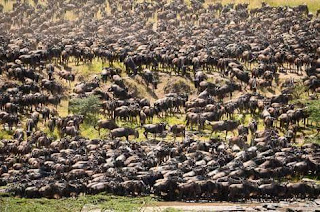1:The Serengeti is a vast ecosystem in east-central Africa. It spans 12,000 square miles (30,000 square kilometers) giving rise to its name, which is derived from the Maasai language and means “endless plains.
This region of Africa is located in north Tanzania and extends to southwestern Kenya. The Serengeti encompasses Serengeti National Park and a number of protected game reserves and conservation areas maintained by the governments of Tanzania and Kenya. The region hosts the largest mammal migration in the world and is a popular destination for African safaris.
2:Altitudes in the Serengeti range from 3,020 feet to 6,070 feet (920 meters to 1,850 meters) The usually warm and dry climate is interrupted by two rainy seasons — March to May, and a shorter season in October and November.
3:The Serengeti landscape is quite varied with flat-topped acacias (a genre of shrubs and trees), rolling plains and open grasslands that are bordered by hills and rocky formations. Extreme weather conditions plague the area, with harsh winds combining with heat to create a harsh environment.
4:The expansiveness of the Serengeti is interrupted by Ol Doinyo Lengai, the only active volcano in the area and the only volcano that still ejects carbonatite lavas that turn white when exposed to air. When it rains, the ash turns into a calcium-rich material that is as hard as cement.
5:The southeastern area lies in the shadow of the Ngorongoro highlands and is composed of shortgrass treeless plains as this area does get rain. Some 43 miles (70 km) west, acacia woodlands rise suddenly and extend west to Lake Victoria and north to the Loita Plains.
6:The landscape is dotted with a number of granite and gneiss outcroppings known as kopjes, which are large rocky formations that are the result of volcanic activity. The Simba Kopje (Lion Kopje) is a popular tourist stop.
Animals of the Serengeti
7:Blue wildebeests, gazelles, zebras and buffalos inhabit the region, along with lions and spotted hyenas familiar to fans of the Disney film “The Lion King.”
In the 1890s, droughts and a rinderpest epidemic (also known as cattle plague or steppe murrain) took a serious toll on the animal population of the Serengeti, in particular the wildebeest. By the mid-1970s the wildebeest and the buffalo populations had recovered.
8:Each year the great wildebeest migration begins in December in the Ngorongoro area of the southern Serengeti of Tanzania, which offers rich grasslands for feeding. This is a huge attraction for tourists, and while many think it is an intense and short-lived phenomenon, it is actually a fairly slow trek. It occurs during this time because there plenty of rain-ripened grass available for the 750,000 zebra that precede 1.2 million wildebeest and then the hundreds of thousands of other plains game bringing up the rear of the migration path.
9:Wildebeests bear their young in February and March, which sparks predators. Then in May as the plains of the south and east dry out the mass moves on to the north and west crossing the Grumeti River, where there is more grass and more a more reliable water supply.
10:Some 250,000 wildebeest die during the journey from Tanzania to Maasai Mara Reserve in lower Kenya, a total of 500 miles (800 km). Death is usually from thirst, hunger, exhaustion, or predation.
But large mammals are not the only ones that make their home in the Serengeti. Gaudy agama lizards and rock hyraxes make themselves comfortable in the numerous granite kopjes, which are formations of huge boulders of sparkling, coarse rock. A full 100 varieties of dung beetle have been recorded, as have 500-plus bird species, ranging from the outsized ostrich to the black eagles that soar effortlessly above the Lobo Hills.
History
11:The Maasai people had been grazing their livestock in the open plains for around 200 years when the first European explorers visited the area. German geographer and explorer Dr. Oscar Baumann entered the area in 1892. The first Brit to enter the Serengeti, Stewart Edward White, recorded his explorations in the northern Serengeti in 1913.
12:Because the hunting of lions made them so scarce, the British decided to make a partial game reserve of 800 acres (3.2 square km) in the area in 1921 and a full one in 1929. These actions became the basis for Serengeti National Park, which was established in 1951.
The Serengeti gained more fame after the initial work of Bernhard Grzimek and his son Michael in the 1950s. Together they produced the book and film “Serengeti Shall Not Die,” an early nature conservation documentary.
13:As part of the creation of the park and in order to preserve its wildlife, the Maasai were relocated to the Ngorongoro highlands, a move that still elicits much controversy.
PLEASE LIKE OUR Blog ,pages ,AND SHARE!!
https://www.facebook.com/Kilimanjaro-Dream-Adventures
Book your trip now to save 20%discount.
https://www.facebook.com/Kilimanjaro-Dream-Adventures
Book your trip now to save 20%discount.




















No comments:
Post a Comment